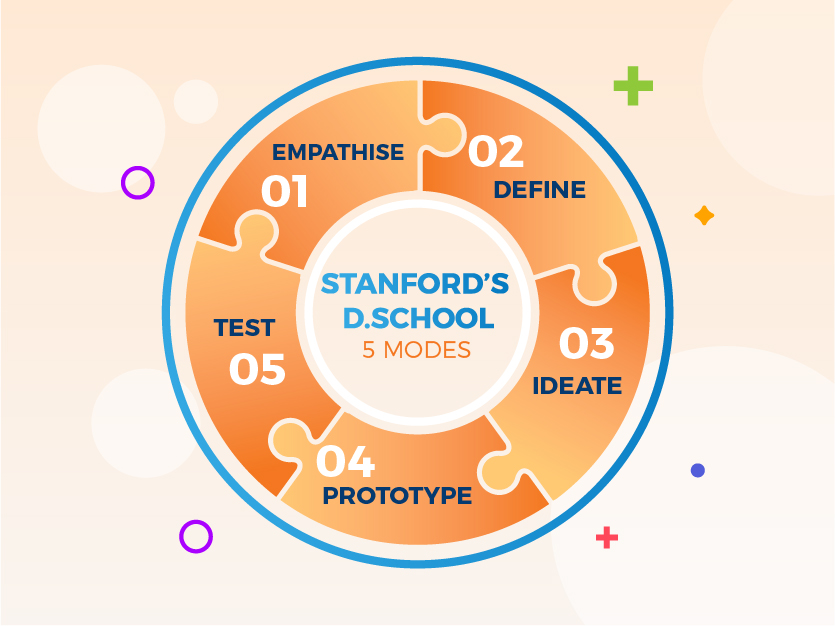

Design thinking your content

How do you encourage innovative thinking and creative problem solving when it comes to your content strategy?
As a business, you’re always looking for ways to better identify, understand and meet the needs of your clients. However, if you only look at a problem from the point of view of a business owner, you’ll miss things your clients see.
Defining who will be using the end product is key to understanding exactly how to develop it. This is what design thinking is all about. It’s the same when it comes to developing content — are you giving your audience content that they want, need and value?

Adopt a design thinking approach
Despite its name, design thinking has little to do with customising fonts or choosing colour schemes. Colloquially referred to as “thinking outside the box”, many successful companies adopt design thinking to help them discover and address customer needs. This process, according to Stanford’s d.school, comprises five “modes”: empathise, define, ideate, prototype, and test.
- Empathise: Building empathy for users gives you insights into their needs that you can use to design innovative solutions. What are some gaps that are not being met? You need to know who you’re designing for — you’re trying to solve their problems after all.
- Define: Framed by the needs of your target audience, define your problem statement. Clearly articulate what it is that you want to solve for your users.
- Ideate: Use the problem statement as a springboard to brainstorm for potential solutions. Cast your net wide: the goal here is to explore a broad range of possible solutions, both in terms of quantity and scope.
- Prototype: Turn ideas into realities. When it takes physical form, people can experience and interact with it. What you learn from these interactions drives even better understanding (“empathy”) and gives shape to successful solutions.
- Test: The most crucial step in the process. Gather feedback, refine solutions, and continue to learn about your users. What do they like about it? What do they not like about it? What’s missing? Armed with this new information, head back and improve on the prototype.

User-centric focus
What really sets design thinking apart from the traditional methods of problem-solving is that it revolves around the user — not the production process or end-product in question. What matters here, is how people are going to use and experience the product.
However, it’s easy for companies to lose sight of their end users. This is where design thinking comes into the picture — to remind those on top to stay connected to their audience.
Andrew Crombie from ScalpelWorks specialises in design thinking.
Speaking about his experience working in the healthcare industry, he says, “A lot of companies tend to be very product-centric, producing a drug and pushing it out there. They’re also pushing out a bunch of information, to educate doctors and pharmacists on their drug. But they don’t really understand who they’re talking to; they don’t talk to the pharmacist as a small businessman, for example. The great thing about design thinking is it flips this on its head, and forces you to start from the customer and work to understand their journey and what they’re trying to achieve.”
Without a user-centric focus, companies run the risk of being trapped in an ivory tower, affecting their ability to craft an appropriate solution for the very users they intended to serve. What matters here is that the design thinking approach starts with user data, and creates solutions that address real needs of actual users.
Watch what Andrew has to say about design thinking when it comes to crafting a content strategy.
Applying design thinking to content
The whole purpose of content creation is to engage consumers on a deeper level.
“Advertising only goes so far, but content is really good at building a deeper and richer understanding, without just being product-focused or brand-focused. It builds the richness — the muscle on the bones around a brand and around your offer,” says Andrew.
The last thing any company wants to do is to alienate their target audience. Sitting around in the office, deliberating over what they think their users would like — instead of hearing it directly from the users themselves — presents a very big disjuncture between both parties.
Unfortunately, this does seem to be the reality. When it comes down to content creation, many companies don’t pay attention to the needs and behaviours of their audience. This is reflected in the lack of a targeted and well-documented content marketing strategy.
In fact, only 41% of businesses have a documented strategy that guides their content creation. This is in spite of the fact that the same study showed that a documented content marketing strategy has ties to success: 69% of successful marketers document their content strategies.
A design thinking approach forces the companies to recalibrate their efforts to craft content that’s actually useful for their audience.
“With design thinking, you can go back. If you understand the customer, you can work out exactly what their problems are at different stages, and what content you can deliver that’s true to your brand, that will help them best at that point,” says Andrew.
“Advertising only goes so far, but content is really good at building a deeper and richer understanding, without just being product-focused or brand-focused. It builds the richness — the muscle on the bones around a brand and around your offer,” says Andrew.
The last thing any company wants to do is to alienate their target audience. Sitting around in the office, deliberating over what they think their users would like — instead of hearing it directly from the users themselves — presents a very big disjuncture between both parties.
Unfortunately, this does seem to be the reality. When it comes down to content creation, many companies don’t pay attention to the needs and behaviours of their audience. This is reflected in the lack of a targeted and well-documented content marketing strategy.
In fact, only 41% of businesses have a documented strategy that guides their content creation. This is in spite of the fact that the same study showed that a documented content marketing strategy has ties to success: 69% of successful marketers document their content strategies.
A design thinking approach forces the companies to recalibrate their efforts to craft content that’s actually useful for their audience.
“With design thinking, you can go back. If you understand the customer, you can work out exactly what their problems are at different stages, and what content you can deliver that’s true to your brand, that will help them best at that point,” says Andrew.

Don’t do content for content’s sake
With all the content that’s being pushed out right now, it might just seem like everyone is jumping on the bandwagon. Andrew likens it to the “sexy new toy in the marketing sphere”: content can be very powerful at creating impact, but therein lies the danger.
“It really pays, in terms of not wasting money and getting maximum value out of content, to go and talk to guys who really know what they’re talking about. Content strategists, content specialists — they can advise you. They’ll ask you how this fits into what you’re trying to do. They’re trying to understand your brand and how the content is going to help you and advise you when not to do stuff,” says Andrew.
When businesses create content for content’s sake, without crafting anything meaningful that meets the needs of their target audience, they run the risk of wasting resources on a marketing effort that just isn’t creating any value.

All for the customer
Adopting a design-thinking approach can help businesses put things into perspective. It teaches them to say no to doing things that might be potentially damaging or wasteful, and channel their efforts into areas that actually benefit their consumers.
At the end of the day, it’s all about the client. “It’s not about trying to do something to the customer, it’s trying to do something for the customer,” says Andrew.
Read more from Click2View:
- Don’t write out influencers — they’re here to stay.
- Do you have your digital content marketing strategy down?
- Ever thought about what content marketing and traditional newsrooms have in common?
Sign up to our newsletter for more.
Click2View is Southeast Asia’s premiere full-service independent B2B content marketing agency servicing clients like Microsoft, Google, Visa, Prudential, and the Lee Kuan Yew School of Public Policy.








